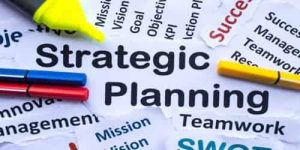
In today’s dynamic and highly competitive business environment, developing and implementing an effective competitive strategy is essential for organizations to thrive and outperform their rivals
This article explores the key elements of competitive strategy and highlights the importance of gaining a competitive edge in a rapidly changing market
1. Understanding the Competitive Landscape:
To gain a competitive advantage, organizations must first thoroughly understand the competitive landscape in which they operate. This involves analyzing competitors, identifying their strengths and weaknesses, and assessing their strategies. By understanding the market dynamics and competitors’ positioning, businesses can identify opportunities to differentiate themselves and develop strategies that exploit their unique strengths.
2. Differentiation Strategy:
One approach to gaining a competitive edge is through differentiation. Organizations can differentiate themselves by offering unique products, services, or customer experiences that set them apart from their competitors. This can be achieved through innovation, superior quality, customization, or exceptional customer service. By differentiating themselves, businesses can attract and retain customers who value the unique benefits they provide.
3. Cost Leadership Strategy:
Another competitive strategy is cost leadership, which involves becoming the lowest-cost provider in the market while maintaining an acceptable level of quality. Cost leadership allows organizations to offer competitive prices, which can attract price-sensitive customers and create a barrier for new entrants. Achieving cost leadership requires efficient operations, economies of scale, strategic sourcing, and continuous cost optimization efforts.
4. Focus Strategy:
A focus strategy involves targeting a specific market segment or niche and tailoring products or services to meet the unique needs of that segment. By focusing on a specific customer group or geographic area, organizations can develop a deep understanding of their target market and deliver superior value. This strategy allows businesses to concentrate their resources and efforts on a specific market, enabling them to build strong customer relationships and establish a competitive advantage.
5. Continuous Innovation and Adaptation:
In a rapidly changing market, organizations must embrace a culture of continuous innovation and adaptation to maintain a competitive edge. This involves investing in research and development, monitoring market trends, and staying ahead of customer demands. By consistently innovating and adapting to evolving customer needs, organizations can differentiate themselves from competitors and stay relevant in the market.
Conclusion:
In a dynamic market, gaining a competitive edge is crucial for organizations to succeed and thrive. By understanding the competitive landscape, differentiating themselves, pursuing cost leadership, or adopting a focus strategy, businesses can position themselves strategically in the market. Additionally, embracing a culture of continuous innovation and adaptation allows organizations to stay ahead of the competition and meet evolving customer demands. With a well-defined competitive strategy, organizations can navigate the challenges of a dynamic market and achieve long-term success.


